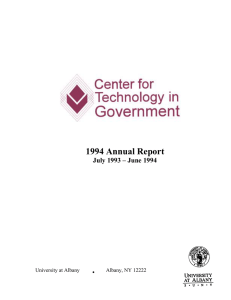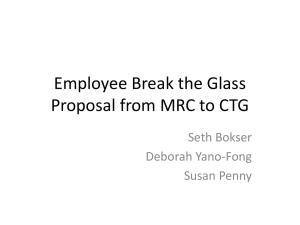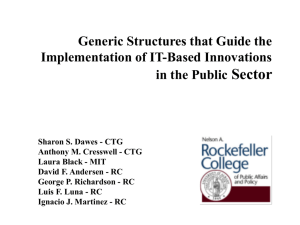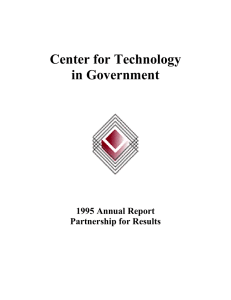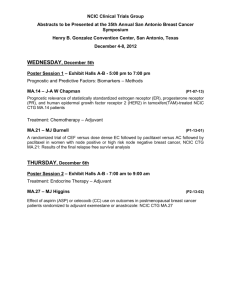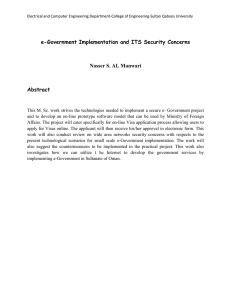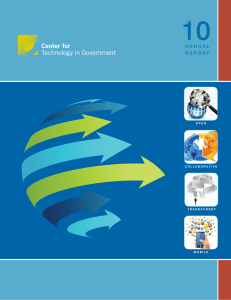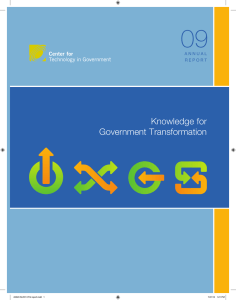Document 14063279
advertisement
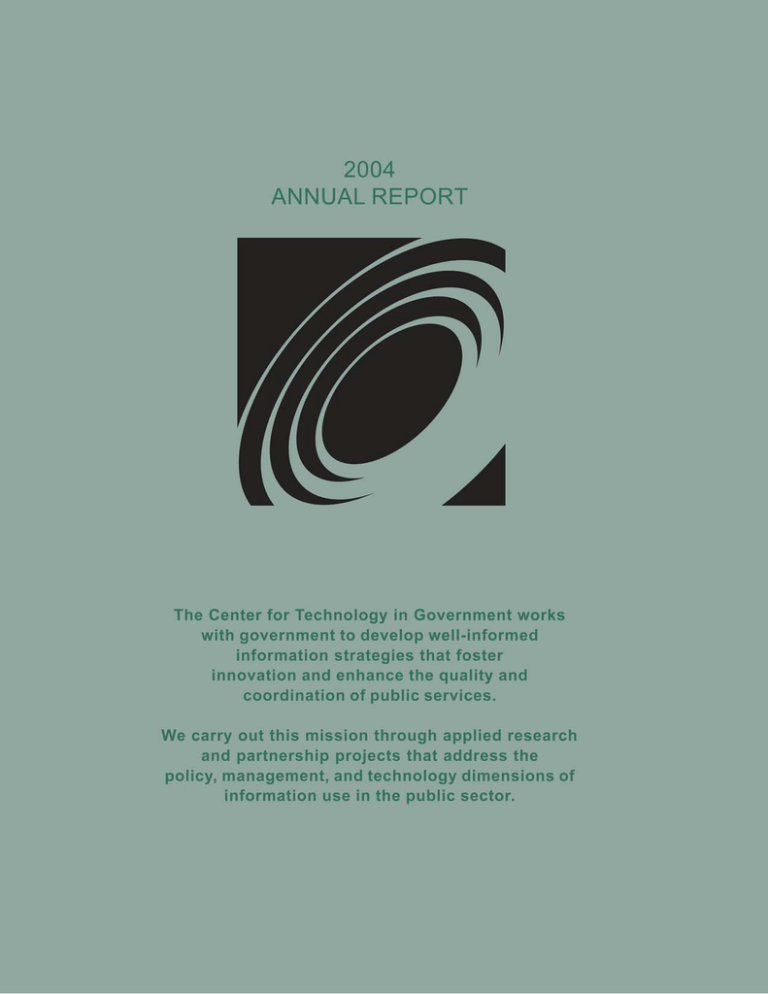
2004 Annual Report Dear Friends, A few years ago, many thought e-government would be a revolution where technology would enable dramatic reforms and restructuring of government operations and services. Since then, we’ve learned that technology is just one piece of the puzzle. For any kind of technology to improve government, it must be accompanied by sound investments in people, policies, and processes. Our projects at CTG this year have been exploring how this combination of technology, people, policies, and processes creates an environment conducive to innovation. For example, unprecedented innovation occurred in response to the World Trade Center crisis as well as in efforts to stem the spread of the West Nile virus. Innovation is essential to improving the way agencies tackle criminal justice and other cross-boundary initiatives. In the coming year we will extend the themes of innovation and integration. These themes are very evident in new work we have just begun under the sponsorship of the Library of Congress to help states build partnerships aimed at preserving our cultural heritage in digital form. We will also be cognizant of these themes as we explore how the public sector embraces and adapts to new technologies such as XML. Our growing engagement with the international digital government community promises to bring fresh ideas and ways to compare strategies and progress on information sharing, integration, and governance issues. As always, we remain committed to working through partnerships with government professionals and corporate and academic colleagues, and to disseminating research results and practical resources across the globe, around the nation, and right here in Albany. Sincerely, Sharon S. Dawes Director CENTER FOR TECHNOLOGY IN GOVERNMENT: 2004 ANNUAL REPORT Promoting Partnerships, Fostering Innovation and Improving Government S ince its creation in 1993, the Center has developed expertise and experience through direct engagement with a wide range of government innovation projects. These projects combine hands-on work with practical problems with systematic reflection and formal research to refine and 2004 Projects share the knowledge they generate. 2 Modeling Interorganizational Information Integration Sponsor: National Science Foundation Increasing Information Sharing Effectiveness: A Capability Assessment Model for the Justice Enterprise Sponsor: US Department of Justice New York State-Local Internet Gateway: Prototype Project Sponsor: New York State XML Training Sponsor: New York State A Reconnaissance Study of Parcel-Level Data Use in New York State Sponsor: NYS Office of Real Property Services Increasing Quality, Reducing Costs: An Analysis of Functional and Programmatic Business Processes Sponsor: NYS Department of State Turning to Digital Government in a Crisis: Coordinating Government’s Response to the World Trade Center Attacks Sponsor: National Science Foundation New Models of Collaboration for Delivering Government Services Sponsor: National Science Foundation Exploring the Feasibility of a Digital Government Journal Sponsor: National Science Foundation Our expertise is drawn from the complex interactions of information technology with government programs and organizations, and developed over the Center’s decadelong pursuit of its mission: to improve government through applied research and partnership projects that address the policy, management, and technology dimensions of information use in the public sector. The goal of every CTG partnership project is to build knowledge that improves the way government works. CTG projects have helped state, local, and federal agencies increase productivity and coordination, reduce costs, enhance quality, and deliver better services to citizens and businesses. The results of each project add to a growing knowledge base designed to support the work of both government professionals and academic researchers. Our partnership projects apply a well-tested, proven set of techniques that can be tailored to each situation. These techniques recognize the importance of policy, management, and technology factors in all information work. CENTER FOR TECHNOLOGY IN GOVERNMENT: 2004 ANNUAL REPORT Using this broad perspective, CTG works closely with agency partners to choose the best methods for the job. These typically include stakeholder analysis and environmental scanning to assess the policy and social environment, along with focused surveys of best practices in similar settings. A typical project also includes business process and work flow analyses to link information resources and technologies to their programs and customers. The CTG approach also includes broad participation and representation of user and stakeholder perspectives, building effective collaboration on project design, planning, user requirements and technical specification. Large and small group facilitation, team building, project support, and training methods are critical process tools used to build the relationships needed to achieve project goals. When tasks call for specific prototypes, test beds, or other technical products, CTG employs rapid application development and testing methods, along with engaging partners with specialized development skills where needed. Cost analysis, surveys, focus group methods, and technical performance evaluation techniques fill out the CTG tool set available for project work. Since inception in 1993, CTG has: Conducted 25 projects with state, local, and federal government partners; Partnered with 57 agencies, 42 companies, and 14 research organizations; Produced over 60 publications; Developed 12 prototype systems; Received 16 research grants and contracts for over $5.5 million; Won 8 state and national awards; and Supported more than 20 doctoral dissertations and masters projects. CENTER FOR TECHNOLOGY IN GOVERNMENT: 2004 ANNUAL REPORT 3 Modeling Information Integration Across Government V ery few service needs or important public issues today can be addressed by single organizations acting alone. Many of our needs as a society demand that perspectives, information, and other resources be shared across organizational and jurisdictional boundaries. In some cases, agencies or levels of government need to integrate their work processes and information flows into complex joint operations. With a grant from the National Science Foundation, CTG is developing and testing dynamic models of information integration in two critical policy areas: criminal justice and public health. This past year, the Center completed an intensive six-month information integration initiative with the CIOs and IT directors from New York State’s major criminal justice agencies. In the area of public health, we completed a retrospective case study on New York State’s response to the West Nile virus outbreak in 1999 and 2000 augmented by in-depth interviews with public health professionals in New York, Colorado, Connecticut, North Carolina, and Oregon. This multidisciplinary study is exploring two questions: What are the critical factors and processes involved in integrating information across levels and agencies of government? How do IT and social factors interact to influence the effectiveness of interorganizational information integration? A two day reflection workshop provided practitioners and researchers an opportunity to consider the draft models and to participate further in their refinement. The feedback we gathered was used to refine the models before testing in a national survey, which is the third phase of the project, to be conducted in 2005. The survey will focus on: development of specific social and technical capabilities; specific management and collaborative techniques; leadership, decision-making authority, and resources; existing technologies and cross-organizational relationships; and decision-making participation by data owners and users. partners NYS Criminal Justice Information Technology Group NYS Depar tment of Health National Science Foundation University at Albany 4 CENTER FOR TECHNOLOGY IN GOVERNMENT: 2004 ANNUAL REPORT Assessing Capability for Justice Information Sharing S ince 1999, the Center has played an integral role in the US Department of Justice’s (DOJ) effort to build capability for information sharing across the justice enterprise. This past year we received $200,000 from DOJ to build an interactive Web-based resource designed to help justice agencies more effectively share vital public safety information across jurisdictions, agencies, and levels of government. The online toolkit builds on the Center’s work in 2003 to develop a self-assessment guide to help justice organizations develop strategic plans to embark on information sharing initiatives. The toolkits–both the online and print versions–are designed for justice professionals to use when considering or planning for a justice information sharing initiative. The toolkit addresses 16 dimensions designed to give a cross-functional, multi-agency team a more concrete view of what needs to happen to effectively share data. The interactive nature of the online resource enables them to gather data electronically from people working individually, then to combine and analyze it in face-to-face meetings. Using these tools, participants assess their collective capability in crucial areas such as governance, readiness to collaborate, and information architecture. The 5 principles of any information sharing initiative. 1. Success depends on the combination of capabilities that exist across partners. 2. Capability is specific to a particular initiative, setting, and group of organizations. 3. The necessary knowledge and experience lies in many people working in different places in their organizations. 4. Information sharing requirements and capability change over time. 5. Fact-based action plans require candid assessments of the gaps between requirements and capabilities. partners US Depar tment of Justice, Office of Justice Programs, Bureau of Justice Assistance National Association of State Chief Information Officers (NASCIO) National Governors Association (NGA) CENTER FOR TECHNOLOGY IN GOVERNMENT: 2004 ANNUAL REPORT 5 Bridging the Enterprise Across the State-Local Divide O ver the past decade, state agencies and local governments throughout the US have increasingly used information technology (IT) and networks to support government services and internal business operations. Today, state and local government use of IT relies on a growing number of independent systems that each support only one business function or satisfy one particular program need. Usually data entered into one system cannot be used in another. Numerous duplicate requests for information are made and fulfilled as individual organizations respond to uncoordinated requirements. This multiplicity of systems and duplication of work is an impediment to efficient work, as well as a financial strain, because many applications require their own hardware, software, security, financial accounting, and business rules. In 2004, we worked with state, local, and corporate partners to build the New York StateLocal Internet Gateway Prototype. Our objective was to identify the policy, management, and technology implications of building a portal-like system that would channel multiple state-local business processes through one place on the Internet. Recommendations for building an enterprise across the state-local divide. Build relationships—Long term, peer-to-peer business partnerships help ensure the success of a statelocal intergovernmental system. Take an enterprise approach—Lay the groundwork by focusing on issues such as infrastructure, security, data, usability, and information policies. Employ practical strategies—Joint state-local governance, effective communication, business process analysis, field visits, prototyping, and adequate training and support are all strategies that help bridge the state-local divide. The Gateway prototype used three intergovernmental business operations—property transfers, dog licensing, and the maintenance of a database of government officials—to test the feasibility of channeling multiple processes through one interface. Participants overwhelmingly judged the prototype and its inclusive project management approach “a better way of working.” partners AT&T Foundation CGI Information Systems & Management Consultants, Inc. Keane, Inc. Microsoft Corporation Ohio State University 6 CENTER FOR TECHNOLOGY IN GOVERNMENT: 2004 ANNUAL REPORT Weaving Web Sites with XML H ow do new technology innovations make their way into the public sector? That’s a question we have been exploring since our inception. XML is a prime example. As government agencies explore ways to expand and improve online services and information, they are confronted with the growing size and complexity of their existing Web sites and Web technologies. One technology offering a potential solution is growing in popularity and acceptance across government. EXtensible Markup Language (XML) is a set of rules for The 411 on E-Government designing text formats that help structure data. XML makes it easier for a computer to generate data, read data, and ensure that the data strucThis year, Federal Computer Week listed ture is unambiguous. the top Web sites for information on eThis year, the Center has offered six XML classes to more than 60 individuals from various New York State agencies. In conjunction with these classes, Center researchers are following the adaptation and implementation of XML in government agencies through surveys of workshop attendees. Follow-up focus groups will be conducted to explore the issues participants have faced in bringing their new knowledge of XML to their organizations’ Web sites. This ongoing research attempts to understand the enablers and barriers to the adoption of XML as well as other IT initiatives. government. It placed CTG at the top of its list for our research results, case studies, and publications: “The fruit of the Center’s research labors is freely available online or in the form of downloadable reports. The site’s Publications section lets users browse reports alphabetically or by theme: Enabling E-Government, Collaboration and Integration, Electronic Records, Making IT Investments and Strategic Use of Information. The Center’s recent publications include a handbook on understanding value and risk in government IT investments and an online guide describing collaboration models for delivering government services.” In August 2004, we presented preliminary findings at the Academy of Management Conference in New Orleans. The paper presented various nuances of XML adoption and implementation based on CTG’s use of XML to redesign our own Web site. It explains how the new technology provides for an embedded content management process that improves the way design, content, and structure move from design to a user’s browser. partners Altova NYS Office for Technology CENTER FOR TECHNOLOGY IN GOVERNMENT: 2004 ANNUAL REPORT 7 Applying Research Close to Home A s an applied research center, learning and application go hand-in-hand. The methodology in our Making Smart IT Choices guidebook was developed from research results and now returns value as we apply it to new work. A Reconnaissance Study of Parcel-Level Data Use in New York State This year we began working with the New York State Office of Real Property Services (ORPS) to conduct a reconnaissance study of the use of parcel data in New York State. The study will help ORPS better understand how local and state government and others use parcel data. The results will focus on the current and potential value of parcel data as an e-government data resource that can be used by government, business, and non profits in New York. Analyzing Functional and Programmatic Business Processes We are also working with the New York State Department of State’s Division of Coastal Resources to improve its grants review and funding process. This partnership is working to generate recommendations that will help the Division develop short and long term investment strategies to improve its business processes and performance. Both of these projects enable us to apply our research in ways that improve state government operations and services in New York State and broaden our collaborative relationships with government agencies close to home. 8 CENTER FOR TECHNOLOGY IN GOVERNMENT: 2004 ANNUAL REPORT Promoting National and International Digital Government Research G overnments all over the world are using information and communication technologies (ICTs) to expand and improve services and operations. To learn from these experiences, the Center is engaging in expanded research collaborations in several national and international directions. Building the US Digital Government Research Community CTG conducted an NSF-funded study of the feasibility and desirability of a scholarly journal devoted to digital government research. The study surveyed the opinions of 188 digital government researchers regarding publication challenges, outlets, and preferred strategies for increasing the impact and visibility of digital government research. Respondents favored both a dedicated journal and special issues in existing journals. The national Digital Government Conference, dg.o, is a key venue for sharing results and building the digital government research community. This year, CTG researchers co-chaired the conference committee, served as reviewers, and presented six papers and posters. Sharing International Research Experiences The dg.o2004 conference was also the venue for the first ever research workshop between NSF and European Union research grantees. The event was facilitated by CTG and has launched a regular series of discussions and meetings among US and European researchers. International research exchanges provide an opportunity to share knowledge and compare experiences that cross the boundaries of governance and nationality. This year we hosted two of our own international research exchanges with digital government scholars and practitioners from the University of Rome Tor Vergata and CEFRIO in Quebec, Canada. These exchanges helped to increase our collective understanding of digital government issues and build collaborative research partnerships that support our work with government. In addition, CTG researchers were members of US-NSF delegations to several international events including a bi-lateral Hungarian-US workshop on e-government in Budapest, the European Union Information Society Technologies conference in Milan, and an international workshop on e-government in developing nations, which was held in Bangalore, India. Host to Visiting Scholars This past year CTG launched a new Visiting Scholars Program, which enables us to host individual researchers from other institutions. Last year, David Landsbergen from Ohio State University spent part of his sabbatical working on an evaluation strategy for CTG’s State-Local project. Marijn Janssen, a member of the faculty at Delft Technical University in the Netherlands, worked with us on international e-government business models. CENTER FOR TECHNOLOGY IN GOVERNMENT: 2004 ANNUAL REPORT 9 2004 Reports and Guides ... T he Center released four new products in 2004 intended to support public sector managers and organizations in the use of information, technology, and collaborations to improve government. Making Smart IT Choices: Understanding Value and Risk in Government IT Investments This year, we updated our Making Smart IT Choices handbook with a series of skills, techniques, and tools that can help government managers develop the information to build a solid business case for IT investments. The full handbook presents a tested methodology for defining needs, identifying stakeholders, investigating alternatives, and making smart IT decisions. New Models of Collaboration for Delivering Government Services: A Guide for Managers Governments around the world are experimenting with public service delivery systems that rely on cross-boundary collaboration among government agencies or between government and the private and nonprofit sectors. This guide focuses on the key elements of these new working arrangements of particular importance to the people who will design and manage them. 10 CENTER FOR TECHNOLOGY IN GOVERNMENT: 2004 ANNUAL REPORT Support the Work of Government Bridging the Enterprise: Lessons from the New York State-Local Internet Gateway Prototype The New York State-Local Internet Gateway Prototype was built to identify, demonstrate, and evaluate key factors associated with the design, development, and deployment of a single point of contact for G2G work among state and local governments. This report emphasizes the importance of relationships, enterprise principles, and practical strategies. Information, Technology, and Coordination: Lessons from the World Trade Center Response Research into what organizations did in the midst of the World Trade Center response provides valuable lessons for improving crisis response and emergency management and planning. Equally important, the lessons reveal that interdependencies of human, organizational, and technological resources may benefit overall government operations in normal times. CENTER FOR TECHNOLOGY IN GOVERNMENT: 2004 ANNUAL REPORT 11 Building on Strong Foundations and Generosity of Our Partners O ur growing program is made possible by the commitment and generous support of government, corporate, and academic partners. From in-kind donations of equipment and expertise, to grants for applied research, these partnerships account for more than half of our total resources. CTG’s total resources for the past year were valued at $2.1 million, with federal research grants providing $385,000 of the total. $920,000 came from New York State through the University’s annual budget allocation. Another $137,000, came from contractual work with government agencies and fee-based education programs, and $140,000, or 7 percent, from private foundation grants and multiple sponsored programs. Government, corporate, and academic partners furnished the other 25 percent of our resources, $530,000 worth of in-kind contributions such as hardware and software, expert consulting, and staff time devoted to projects. Corporate Partners Bring State-of-the-Art Resources When it comes to technical expertise, hardware, and software, our corporate partners are the key. They apply their specific expertise to support our projects and assist in programs of outreach that share the results. Their knowledge and generosity insure that we employ the latest and right technologies and technical strategies to meet project goals. We are grateful again this year, for the continued support of CGI Information Systems and Management Consultants, Keane, Inc., Microsoft Corporation, and AV Sales and Service for bringing technical expertise and experience to the development of the State-Local Internet Gateway Prototype. Thanks also, to our new partner Altova for providing the XML Spy software used in our XML training classes. 12 CENTER FOR TECHNOLOGY IN GOVERNMENT: 2004 ANNUAL REPORT Academic Partners Share Knowledge and Expertise Academic experts in a number of fields at the University at Albany and elsewhere have helped conduct research and shared their expertise on a number of projects this year. These cross-institutional, cross-disciplinary collaborations broaden our own knowledge and sharpen our appreciation for the variety of approaches that can be applied to important public issues. Over the past year we have continued our work with academic partners from around the world including colleagues from Canada, Italy, and the Netherlands, as well as faculty fellows from the University at Albany and other institutions. We value these relationships and are proud of the collective discovery process they encourage and the diverse body of knowledge they create. Government Partners are Teammates in Tackling Challenges Public service is the common thread woven through the fabric of our work. We have worked with representatives from more than three dozen local, state, and federal government agencies this past year to develop information-based strategies to help them meet their program and service goals. Our government partnerships assure that our work remains relevant and usable in the real world. They also raise essential policy, management, and technical questions to be explored on many levels—as practical, conceptual, and theoretical problems. Through interviews, focus groups, workshops, and seminars, our government partners provide invaluable insight into the issues of contemporary government. Their willingness to participate and share their rich and varied experience is vital to our ability to craft models, tools, and guides that contribute to better, more effective government. CENTER FOR TECHNOLOGY IN GOVERNMENT: 2004 ANNUAL REPORT 13 Publications Practical Guides Online Guides Return on Investment In Information T echnology: Technology: A Guide for Managers August 2004 New Models of Collaboration for Delivering Government Services: A Guide for Managers January 2004 Making Smart IT Choices: Understanding V alue and Value Risk in Government IT Investments April 2004 Opening Gateways: Online Workbench December 2003 Untangle the Web: Delivering Municipal Services Through the Internet December 2002 Making a Case for Local E-Government July 2002 Opening Gateways: A Practical Guide for Designing Electronic Records Access Programs January 2002 And Justice for All: Designing Y our Your Business Case for Integrating Justice Information May 2000 Conducting Best and Current Practices Research: A Starter Kit January 2000 Practical T ools for Electronic Records Tools Management and Preservation January 1999 The Records Requirements Analysis and Implementation T ool Tool April 1998 A Cost Performance Model for Assessing WWW Service Investments June 1997 Tying a Sensible Knot: A Practical Guide to State-Local Information Systems June 1997 Developing & Delivering Government Services on the World Wide Web: Recommended Practices for New Y ork York State September 1996 14 Insider's Guide to Using Information in Government November 2000 Selected Journal Articles Designing Electronic Government Information Access Programs: A Holistic Approach, Government Information Quarterly, Volume 21, Number 1, 2004, pages 3-23. Learning from Crisis: Lessons in Human and Information Infrastructure from the WTC Response Response, Social Science Computer Review, Volume 22, Number 1, 2004, pages 1-5. Training the IT Savvy P ublic Manager: Public Priorities and Strategies for Public Management Education Education, Journal of Public Affairs Education, Volume 10, Number 1, 2004, pages 5-17. Digital Government Research: Investigations at the Crossroads of Social and Information Science Science, Social Science Computer Review, Volume 22, Number 1, 2004, pages 5-10. Understanding New Models of Collaboration for Delivering Government Services Services, Communications of the ACM, Volume 46, Number 1, 2003, pages 40-42. Thoughts on Relevance of IS Research Research, Communications of the Association for Information Systems, Volume 6, 2001, article 9. Implications of Legal and Organizational Issues for Urban Digital Government Development Government Information Quarterly, Volume 18, 2001, pages 269-278. Four Realities of IT Innovation in Government The Public Manager, Volume 28, Number 1, Spring 1999. CENTER FOR TECHNOLOGY IN GOVERNMENT: 2004 ANNUAL REPORT Selected Reports and Working Papers H ighlights: Exploring the Feasibility of A Digital Government Journal July 2004 Models for Action: Practical Approaches to Electronic Records Management & Preservation July 1998 Information, T echnology Technology echnology,, and Coordination: Lessons from the W orld T rade Center World Trade Response June 2004 Functional Requirements to Ensure the Creation, Maintenance and Preservation of Electronic Records April 1998 Bridging the Enterprise: Lessons from the New York State-Local Internet Gateway Prototype May 2004 A Survey of System Development Process Models February 1998 Creating and Maintaining Proper Systems for Electronic Record Keeping December 2002 A Step Beyond Research: Fostering IT Innovations in Government October 1997 XML: A New Web Site Architecture September 2002 Partners in State-Local Information Systems: Lessons from the Field October 1997 Finding Our Future: A Research Agenda for the Research Enterprise July 2002 The Future of E-Government June 2002 What Citizens Want from E-Government October 2000 New Y ork State Central Accounting System York Stakeholder Needs Analysis July 2000 Reassessing New Y ork: A Collaborative York: Process June 2000 Web-based Applications for Networked Legacy Systems Spring 1999 Some Assembly Required: Building a Digital Government for the 21st Century March 1999 A Survey of Key Concepts and Issues for Electronic Recordkeeping August 1997 Delivering on the Web: The NYS Internet Services T estbed Testbed December 1996 The World Wide Web as a Universal Interface to Government Services December 1996 A Framework for Evaluating Public Sector Geographic Information Systems December 1995 Balancing Environmental Quality and Economic Vitality in the Adirondack Park December 1995 Sharing the Costs, Sharing the Benefits: The NYS GIS Cooperative December 1995 Evaluating the AP A Prototype: Prospects for APA Providing Cheaper aster Cheaper,, F Faster aster,, and Better Services to the AP A's Customers APA's October 1995 Data Quality T ools for Data Tools Warehousing - A Small Sample Survey October 1998 Supporting Psychiatric Assessments in Emergency Rooms September 1995 New Models of Collaboration: GIS Coordination in New Y ork State York October 1998 Title Imaging Project with NYS Department of Motor V ehicles Vehicles 1994 CENTER FOR TECHNOLOGY IN GOVERNMENT: 2004 ANNUAL REPORT 15 Staff DIRECTOR Sharon Dawes PROFESSIONAL STAFF Soumava Adhya, Program Associate G. Brian Burke, Program Associate Gale Butler, Administrative Assistant Donna Canestraro, Program Manager Meghan Cook, Program Manager James Costello, Web Application Developer Anthony Cresswell, Deputy Director Rachel Gaul, Administrative Manager Dubravka Juraga, Program Associate Linda Keane, Administrative Assistant Jane Krumm-Schwan, Director of Administration and Outreach Mark LaVigne, Communication Manager Christina Pagano, Program Associate Theresa Pardo, Deputy Director Fiona Thompson, Program Associate Jon VanDerpoel, Construction Manager Derek Werthmuller, Director of Technology Services FA C U L TY FELL OWS LT LO David Andersen, Public Administration and Policy and Information Science, UAlbany Thomas Birkland, Public Administration and Policy and Information Science, UAlbany Peter Bloniarz, Information Science, UAlbany François Cooren, University of Montreal Ophelia Eglene, Middlebury College Teresa Harrison, Communication, UAlbany David Landsbergen, Ohio State University George Richardson, Public Administration and Policy and Information Science, UAlbany Thomas Stewart, Center for Policy Research, UAlbany Tomek Strzalkowski, Computer Science, UAlbany Giri Tayi, Management Science and Information Systems, UAlbany Jing Zhang, Clark University GRADUATE ASSISTANTS Jacob Baker, Journalism Tamas Bodor, Communication Fikret Demircivi, Criminal Justice J. Ramon Gil-Garcia, Public Administration and Policy Natalie Helbig, Public Administration and Policy Luis Luna-Reyes, Information Science Jiaoheng Meng, Computer Science Shalini Paliath, Computer Science Jing Qian, Computer Science Carrie Schneider, Political Science Benjamin Schwartz, Public Administration and Policy Bhagya Thirumuru, Business Administration 16 CENTER FOR TECHNOLOGY IN GOVERNMENT: 2004 ANNUAL REPORT


